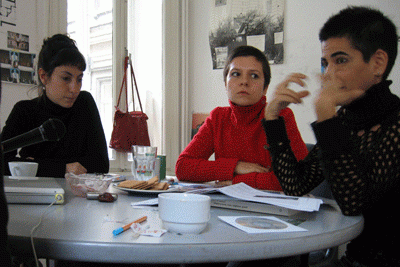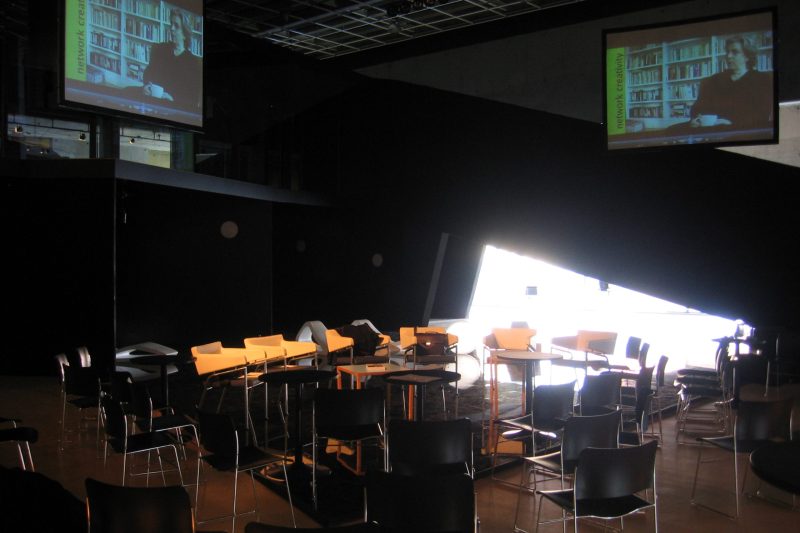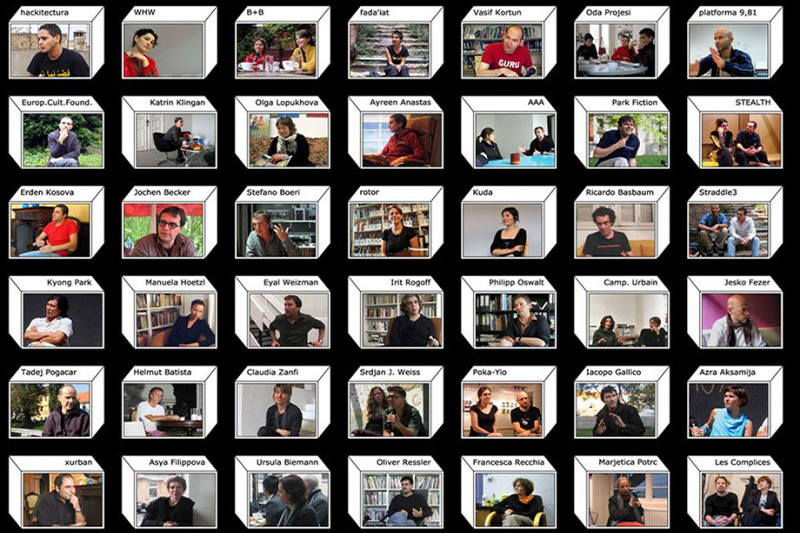- Interview
- Berlin
- 08.05.2006
- NETWORKED CULTURES
conversation with Jochen Becker
PM/HM: You are one of the contributors of the project ErsatzStadt that pursued various lines of critical engagement with contemporary urban realities. Some were more theoretical investigations, such as the book series metroZones; others had to do with direct interventions into the urban fabric. How does this particular approach of combining political engagement with enquiries into artistic and architectural practices resonate with the political and cultural climate in Berlin?
Jochen Becker: Actually, it was a critique of Berlin’s recent discourses and a (temporary) farewell to Berlin, too. We were getting really bored with the ongoing description of the so-called Europäische Stadt (European City), which was one of the prime movers for Berlin’s developers in (re)constructing Berlin. In a lot of projects and initiatives, for instance InnenStadtAktion or AnbauNeueMitte, we fought against the reactionary perspective that often dominates the debate about Berlin. We asked which Europe they were talking about – that of Belfast, Belgrade or Istanbul? Berlin’s developers tried to avoid US-American or Japanese cities. But from a broader perspective, there are many other models of urbanisation, of daily activities, though at the time we still didn’t know much about them. It was with the book Metropolen, which we were commissioned to write in a condensed format of only ninety-five pages, that we really started to discover the interesting new dynamics at work beyond the European City, and these – as we later learned and are still discovering – are influencing Berlin, too.
We wanted to look at what is beyond the idea of civitas, such as written about by Richard Sennett in his book The Conscience of the Eye: The Design and Social Life of Cities with regard to civilized bourgeois society with its rules and regulations, well-functioning orders and the Fordist dream of a welfare state. We wanted to look beyond all this and adopt a more global perspective. We wanted to explore how informal structures emerge in the Global South, structures that are now obviously also evolving in the middle of Europe; how the welfare state is declining and people have to help themselves; or how the banlieues are trying to survive via self-organisational processes called “shadow economies”. Migration and so-called liberalisation – “you’ll have to help yourself, because nobody’s going to help you”–, the kinds of processes we read about in Istanbul, Lagos or Kabul, are growing significantly – I call this the International Informal Style. You notice that there are functioning structures and they’re not at all exotic. But you have to be careful about saying, “Hey, that’s working in some ways, let’s do it here, too”, because that’s really the neoliberal way of doing things. On the other hand, it’s good to be prepared, to learn about what’s coming, in order to keep what’s good and emancipative, and get rid of what’s either purely exploitative or terribly bureaucratic. This relates – in a very general way – to the idea of metroZones, and how to step beyond Berlin’s perception of the European City.
PM/HM: Your current work is strongly concerned with reframing local issues by bringing them in touch with distant geographies that may initially seem unconnected. Can you give us some examples that highlight these oblique links between the urgency of Europe or the so-called European City and places elsewhere?
Jochen Becker: We started off by discovering that the idea of the European City was also present in Leopoldville, the capital of the Belgian Congo, which had been shaped by King Leopold II and was renamed Kinshasa after liberation. This African city was a colonial product and is an example of how the European City exists not only in Europe but also all over the colonised world. And by exploiting the Belgian Congo, Leopold II was able to transform Brussels into what now looks like a European City, and it became the capital of Europe. He pursued a kind of Haussmannisation, destroying old Brussels and building axes or, for instance, the imperial Palace of Justice. For what we now call the classical European City often evolved in the colonies. Though it was not something that happened separately, for relations were close between Europe and the colonies. And it was also not a one-way street: the situation was complex and is still so now. Due to current migration policies, the information society and so on, relations are even livelier today between the former colonies and postcolonial Europe. So our new, ongoing research project is called “From/To Europe” and explores such issues.
For years now, Mohammed has been the most common name chosen for boys in Brussels, and this really says something about how cities as worlds are emerging within Europe, within our European cities, in a very concrete sense: if you want to find a “Nollywood” production, a DVD from Nigeria, you just have to go to the next “Afro shop”, you don’t have to order it from Lagos. Such communities exist here and – if you want to watch the DVD – you can find them just around the corner. Another example: the largest diaspora of Afghans in Europe lives in Hamburg.
We’ve discovered how close diasporic relationships are towards the respective country of origin, and that this is the case even within European cities; it is also a tendency that is bound to increase with the presence and practices of different peoples. How do peoples survive with the practices they bring with them – often out of sheer need or racial exclusion?
The state is destroying social and political welfare structures, and this is why people with precarious backgrounds are in general forced to exercise a kind of informality: in what ways do they have to betray the state to survive, as well as organize money illegally?
As a postcolonial structure, I think the banlieues reveal how extremely separate societies live in the middle of France: the country is divided in at least three groups. The very rich, who are living more or less directly in Paris; then the downgraded, protesting middle class, who say that Paris is too expensive and so they have to move outside the city – just like the proletarian or post-proletarian population had to do decades ago. The middle class now have to live in the suburbs, between housing estates in the banlieues, which is the third structure. The banlieues have other ways of earning money, and people try to survive and organize themselves socially, and this also includes gangster-like structures. There is hardly any communication between these three groups, a fact that has become very obvious in recent clashes – as has also the existence of an undiscussed colonial background that is related to the crisis in the banlieues. We worked on this in the anti-colonial film group Remember Resistance, in our program Bourdieu in the Banlieue.
With the project City of COOP, we discovered how post-crisis Buenos Aires – formerly the most European city in South America – became part of Latin America, though without giving up the idea of a better life. In Rio, on the other hand, a lot of people have been living in precarious situations for ages. They have no notion of the welfare state, but are used to dealing with crises, which distinguishes them from many people in Argentina who had had no previous experience with such situations. So I think we can all learn a lot.
PM/HM: How can we appropriate these ways of learning you’ve described for local projects, such as for the temporary structure of the project Hier Entsteht at Rosa-Luxemburg Platz in Berlin
Jochen Becker: Well, compare it with Dolmush Xpress – a temporary art project in which you could take a privately owned taxi, solar boat, or horse carriage through Kreuzberg – the idea being to copy practices one-to-one from Istanbul to Berlin. I think this is a rather tenuous idea because it disregards what such things mean within the context of Berlin. True, a kind of temporary structure is also created, one that you might think is similar to Hier Entsteht. But there are differences, and I want to show this with an example: in the 1970s a lot of architects travelled to the Global South. There they discovered informal architectures that offered a kind of relief from what was going on in the post-illusional period after 1968. They also discovered a new freedom of planning, a sort of hybrid dream. When they returned, it turned out to be impossible to implant this into European structures and regulations, but they still tried in a number of ways to introduce participatory architecture as a form of self-made architecture within the laws of Europe. It was also within such an agenda that we connected to what the team of Hier Entsteht was doing. Reconstruction at this location was a form of participatory architecture, and we wanted to know: what does this mean today, and how might we demonstrate and study it within the structure of this project?

Jochen BeckermetroZones
lives and works in Berlin as a critic (taz/die tageszeitung, springerin), project teacher (Hochschule für Gestaltung und Kunst, Zurich) and cultural producer (Baustop.randstadt,-/NGBK, Berlin, 1998; MoneyNations2/Kunsthalle Exnergasse, Vienna, 2000; Urban Control/Forum Stadtpark, Graz, 2001; Werkleitz Biennale, 2002). He is a founding member of BüroBert, co-editor of Copyshop – Kunstpraxis & politische Öffentlichkeit (1993), editor of BIGNES? on recent urban development, and co-editor, with Stephan Lanz, of Metropolen (2001), Space//Troubles (2003), Hier Entsteht (2004), Self-Service City: Istanbul (2004), City of COOP: Buenos Aires/Rio de Janeiro (2004), Kabul/Teheran 1979ff (2006) and Architektur auf Zeit (2006). In 2007 he launched the mediaZones book line, whose forthcoming titles include Nollywood, EuroMaps and Roaming Around.


